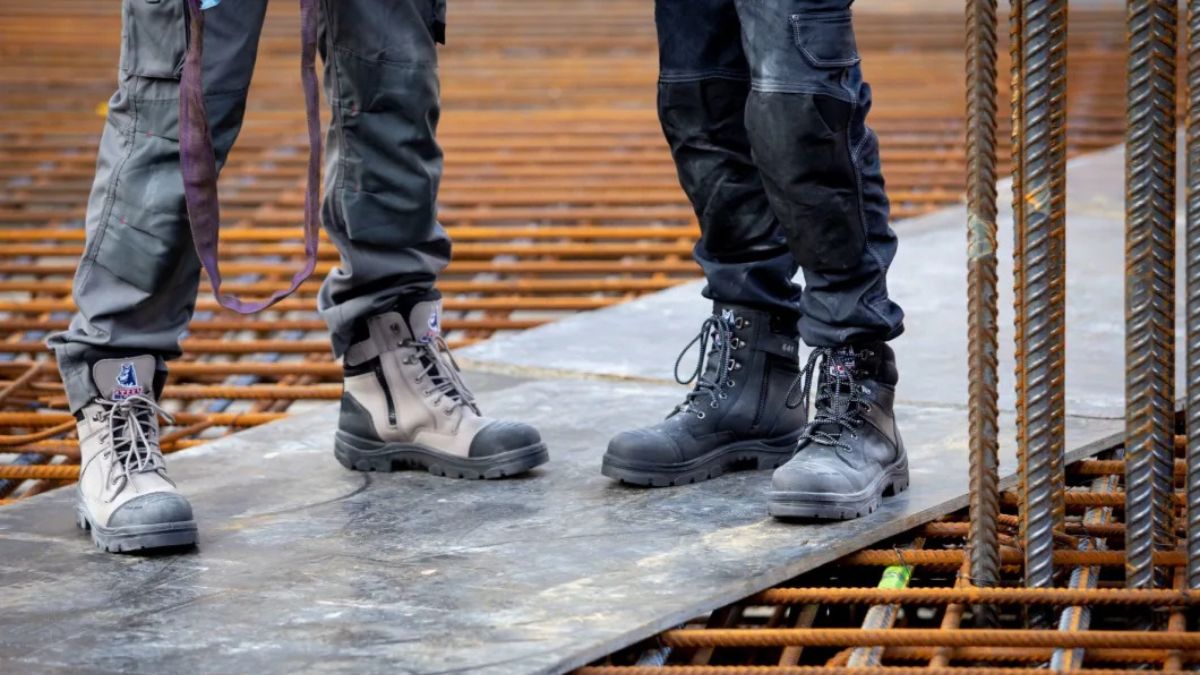
Steel Blue is known for making durable work boots that don’t compromise on comfort. One of the most important decisions when buying a pair is the type of toe protection: steel, composite, or soft.
In this guide, we’ll cover everything you need to know about Steel Blue work boots toe protection. We’ll also compare the different safety toes, so you can choose the right fit with confidence.
Safety Toes in Work Boots
A safety toe is a reinforced cap built into the front of a work boot. Its purpose is simple: to protect your toes from heavy impacts, crushing forces, or sharp objects. These caps are tested against strict industry standards.
In industries like construction, warehousing, manufacturing, and mining, heavy materials and equipment are part of everyday work. A dropped tool or a rolling pallet can cause serious injury without proper protection. That’s why safety toe boots are often required by workplace safety regulations.
But not every job demands maximum toe protection. Farmers, delivery drivers, or workers in light-duty environments may prefer boots without reinforced toes for flexibility and comfort.
Still, when the risk of impact or compression is high, safety toe work boots are the standard choice to keep feet safe.
Why Steel Blue?
Steel Blue has grown from a small Australian startup to a globally recognized name in safety footwear. Here’s what makes the brand stand out and why its work boots are trusted by professionals worldwide.
- Proven Since 1995 – Steel Blue was started by five footwear experts in Perth, Western Australia, who wanted to change the way work boots felt. Their goal was to combine certified safety protection with the comfort of sports shoes. This was a new concept at the time. Today, that same focus continues to guide the brand.
- Focus on Comfort – From the beginning, Steel Blue has invested heavily in technology that reduces foot fatigue. Features like their Trisole® cushioning system and PORON® inserts absorb shock and support the feet through long shifts. This comfort-first approach sets them apart in an industry where boots are often seen as heavy and rigid.
- Built for Work – Steel Blue doesn’t make lifestyle or casual footwear. Their full focus is on safety boots that meet or exceed international standards like ASTM F2413 in the U.S. This specialization ensures every boot is designed with the job site in mind.
- Trusted Worldwide – While the brand started in Australia, Steel Blue quickly expanded into international markets. Today, their boots are sold in the U.S., Europe, and Asia, with authorized distributors helping workers choose the right boot for their needs. In the U.S., they’ve gained popularity among workers who want both protection and comfort.
- Recommended Brand – Steel Blue is the first and only safety boot brand endorsed by the Australian Physiotherapy Association. It is also one of the few to receive the American Podiatric Medical Association’s Seal of Acceptance.
Toe Types in Steel Blue Boots
Steel Blue offers three main options for toe protection: steel, composite, and soft. Each type is built to meet different needs, whether you want maximum protection, a lighter boot, or all-day flexibility.
Steel Toe
Steel toes are the most common choice for protective footwear. A hardened steel cap is built into the boot to shield your toes from falling tools, heavy loads, or machinery.
They’re popular in construction, logging, and other high-risk jobs because they’re tough and reliable.
The downside is extra weight and a colder feel in low temperatures. Steel Blue offsets this with roomy toe boxes and added cushioning for comfort.
Composite Toe
Composite toes use non-metal materials like fiberglass or Kevlar to protect the foot. They’re lighter than steel but still meet the same safety standards.
Since they don’t contain metal, they don’t set off detectors and don’t transfer heat or cold as easily. This makes them a strong choice for hot, cold, or secure environments where lighter boots are a plus.
Composite Toe vs. Steel Toe
- Weight: Composite is lighter, reducing foot fatigue.
- Strength: Both meet safety standards, but steel is slightly tougher under extreme force.
- Comfort in Weather: Composite stays warmer in cold and cooler in heat.
- Metal Detectors: Composite passes through without issue; steel does not.
Soft Toe
Soft toe boots don’t have a reinforced cap. They’re lighter, more flexible, and easier to wear for long hours when heavy protection isn’t required. Farmers, drivers, and warehouse workers often choose them for comfort in lower-risk jobs.
Soft Toe vs. Composite Toe
- Protection: Composite offers certified impact resistance, while soft toe does not.
- Weight: Both are lighter than steel, though soft toe is usually the lightest.
- Cost: Soft toe boots can be less expensive, but the trade-off is safety.
Other Toe Types You’ll See in Work Boots
Beyond steel, composite, and soft toes, some brands use other materials for protection.
Alloy Toe
Alloy toes are made from lightweight metals like aluminum or titanium. They’re just as protective as steel but can be 30–40% lighter, which helps reduce fatigue. The trade-off is they still conduct heat and cold and usually cost more than steel.
Alloy Toe vs. Steel Toe
- Weight: Alloy is lighter.
- Fit: Alloy allows for a more streamlined toe box.
- Durability: Steel edges out alloy in sheer toughness.
- Price: Alloy toes are usually more expensive.
Carbon Toe
Carbon toe boots use carbon fiber, which is both strong and extremely light. They’re among the lightest options on the market and are good for workers who need safety with less bulk. However, they’re less common and often come at a premium price point.
Carbon Toe vs. Steel Toe
- Weight: Carbon is far lighter than steel.
- Strength: Both meet standards, but carbon may be more brittle under certain stresses.
- Cost: Carbon boots are among the priciest.
- Availability: Steel is widespread; carbon is still niche.
Final Thoughts
The right safety toe depends on your job, environment, and comfort preferences. Steel toes bring strength, composite toes provide versatility, and soft toes are perfect when protection isn’t required. Alloy and carbon toes are available in other brands, but Steel Blue focuses on the essentials that cover most workers’ needs.
Choose Steel Blue Boots
Steel Blue makes it simple to match your work boots to your needs. Whether you want the heavy-duty strength of steel, the lighter feel of composite, or the flexibility of soft toes, every pair is built for comfort and protection.
Browse our full collection of Steel Blue boots and find the right fit for your workday.
